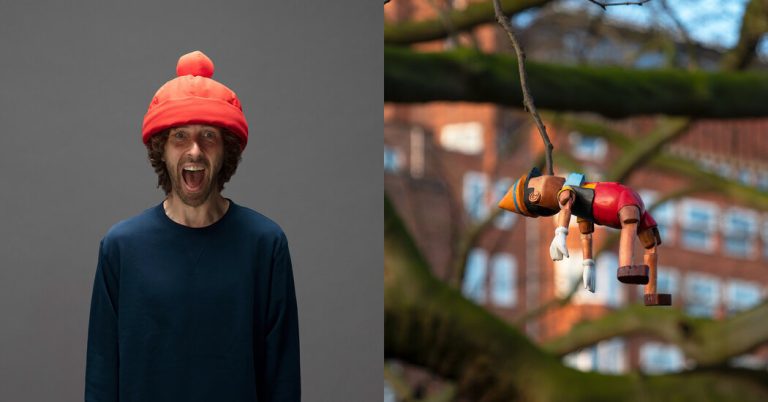In the spring of 2020, at the height of the pandemic, the ever-bustling Dam Square in Amsterdam was deserted, silent and surrounded by concrete anti-terror blocks. Dutch street artist Frank de Ruwe, who goes by the name Frankey, decided that these scary square blocks looked like something more innocent – giant Lego blocks – and that the city needed something to lighten the gloom.
The result? Later that summer, Frankey created and installed a giant yellow-and-black Lego figure of Dutch folk singer André Hazes, whose songs have been pub favorites in Holland for more than 40 years.
“It’s all about seeing the right thing,” Frankey said recently, over coffee in his Amsterdam neighborhood. “I think everyone was looking for some bright news in these dark days.”
Frankey continues to grace Amsterdam with his whimsical, witty street art. Yes, every Saturday, he publishes a new article in the Dutch newspaper Het Parool, as well as on Instagram, but these are only the tip of the iceberg. It transforms any unassuming spot in the city – a sign, an oddly shaped brick, a ledge – into something more playful. You are sure to come across his work on any trip to Amsterdam.
This conversation has been edited and condensed for clarity.
In the press, your street art projects are called “urban interventions”. What does this term mean to you?
I just want to make people smile with my work, that’s the greatest good. A 6 year old and a 90 year old can smile at the same thing. It’s amazing how you can brighten someone’s day with just one item. It’s so easy to be a little friendlier on the streets and I think that’s what I’m doing. And if people want to call them urban interventions, I’m cool with that. It feels a bit like a buzzword, but people have been making fun things to light up the streets for centuries — they’ve always been there. I’m just one of those guys who does too.
When you leave your art on the street, is it legal?
No. It’s illegal. I have some rules for myself, because I love Amsterdam so much. I don’t want to damage the city at all, so all the pieces I make can be removed very easily without leaving any damage. I work a lot with magnets and tie wraps — I probably own every type of double-sided tape in the world. Sometimes I might not know how to build a piece without using screws or kits or whatever. Then connecting it becomes a nice challenge so it’s still safe and people can easily remove it. But it’s still illegal.
Do you know what happens to your pieces when they are removed?
Sometimes the streets are just being cleaned and the cleaner doesn’t even notice there was a work of art to begin with. There is also a group of people who collect art to sell online, believing that my work is worth some money. But what I really like is that I have seen government vehicles with my work on their dashboard. So they removed it, but kept it as a trophy. But if people want to take it or take it home — that’s all fine with me. I think it’s a win-win. Even if he’s gone.
What is your method for placing your pieces on the road?
I always do it during the day. And I’m wearing one of those orange jackets with fluorescent stripes, so I look like a guy who works with the municipality. Whenever I’m doing a big piece and need some space, I bring along some orange traffic cones. It’s been my method for 20 years and I still get away with it.
I read that you have a fake license. It is true that?
It’s just a piece of paper with lots of stamps, saying “I, Frank de Ruwe, give permission to Street Art Frankey to place the other…” But it looks kind of official because of its layout and because I always add a lot of appendices. You’ll have an officer standing there with all these papers, all date-stamped—which, by the way, say “Frankey official” around the date—and they’ll think, “If it’s got a stamp, it must be official.” The same goes for the orange jacket.
You’ve done so many pieces. What is your favorite?
I was really proud to be able to make our former mayor for Paradiso, the music venue. The best musicians in the world have played there. It’s an old church, right in the center of the city — it’s a cultural temple. When I heard that a music venue might not stay forever, I thought that was not possible! It is such a part of Amsterdam. And our former mayor, Eberhard van der Laan, who was so beloved, was also really into arts and culture.
So I made a little bronze sculpture of him, and he’s sitting on top of the Paradiso, holding the building and protecting it with a little smile. And every time I go there, I look up and say, “Yes, this is a good place, protect this building.” I have a lot of pieces that I don’t check whenever I pass them. But I’m really proud of it.
Follow New York Times Travel on Instagram and subscribe to the Travel Dispatch weekly newsletter to get expert tips to travel smarter and inspiration for your next vacation. Dreaming of a future getaway or just an armchair trip? Take a look at ours 52 places to go in 2024.




